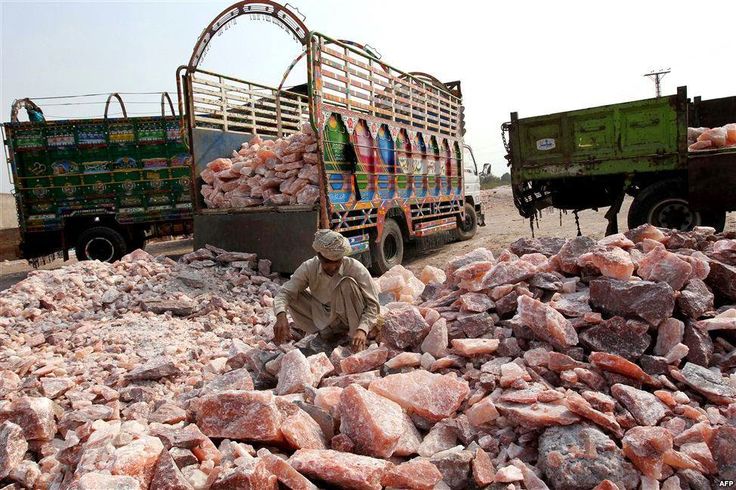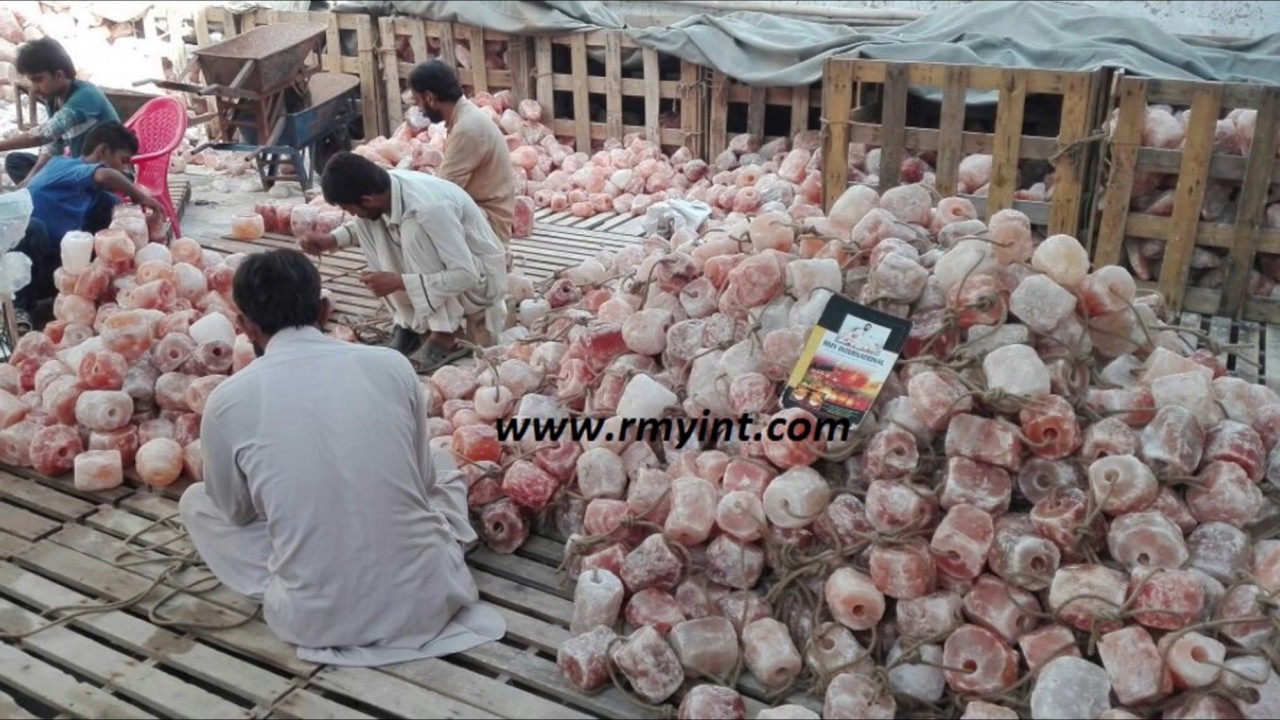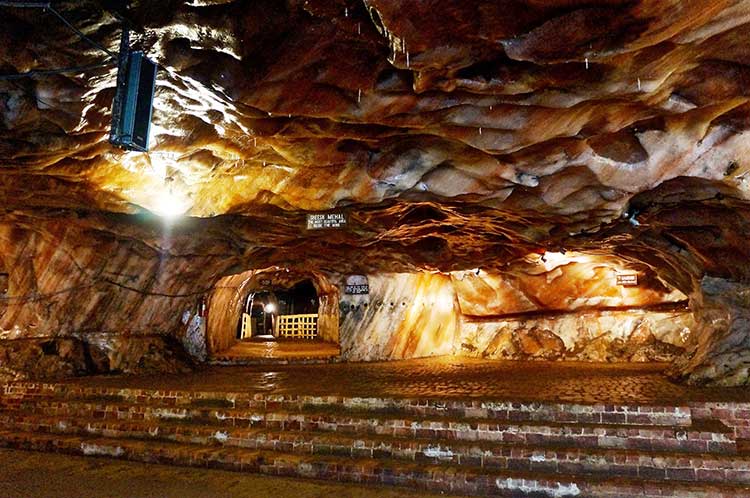ghazi52
PDF THINK TANK: ANALYST

- Joined
- Mar 21, 2007
- Messages
- 101,794
- Reaction score
- 106
- Country
- Location
Himalayan salt is rock salt (halite) mined from the Punjab region of modern Pakistan. The salt often has a pinkish tint due to mineral impurities. It is primarily used as a food additive as table salt, but is also used as a material for cooking and food presentation, decorative lamps, and spa treatments. The salt has been claimed to provide numerous health benefits, but no scientific support exists for such claims.
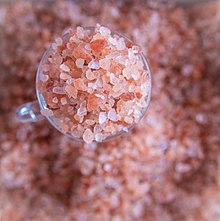
Contents
1 Geology
2 History
3 Mineral composition
4 Uses
5 See also
6 References
7 External links
Geology
Himalayan salt
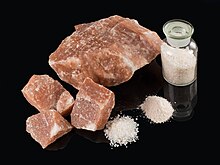
Salt from Khewra Salt Mine near Khewra,
Himalayan salt is mined from the Salt Range mountains, the southern edge of a fold-and-thrust belt that underlies the Pothohar Plateau south of the Himalayas. Himalayan salt comes from a highly folded, faulted, and stretched thick layer of Ediacaran to early Cambrian evaporites of the Salt Range Formation. This geological formation consists of crystalline halite intercalated with potash salts, overlayed by gypsiferous marl and interlayered with beds of gypsum and dolomite with infrequent seams of oil shale. These strata and the overlying Cambrian to Eocene sedimentary rocks have been thrust southward over younger sedimentary rocks and eroded to create the Salt Range. Although Himalayan salt is sometimes marketed as "Jurassic Sea Salt", this salt precipitated in subsiding rift basins along the edge of Gondwanaland much earlier, between 600 and 540 million years ago. The Jurassic period took place 145 to 199 million years ago.
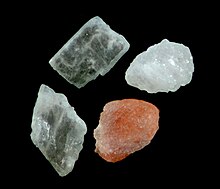
Himalayan salt crystals
History
The first records of mining are from the Janjua people in the 1200s. Himalayan salt is mostly mined at the Khewra Salt Mine in Khewra, Jhelum District, Punjab, which is situated in the foothills of the Salt Range hill system in the Punjab province of the Pakistan to the Indo-Gangetic Plain.
Mineral composition
Himalayan salt crystals
Himalayan salt is chemically similar to table salt. Some salts mined in the Himalayas are not suitable for use as food or industrial use without purification due to impurities. Some salt crystals from this region have an off-white to transparent color, while impurities in some veins of salt give it a pink, reddish, or beet-red color.
Analysis shows the main content of Himalayan salt to be about 96% sodium chloride, with the remaining content consisting of typical minerals, most in minute quantity.
Himalayan salt is nutritionally similar to common table salt, though it lacks the beneficial iodine added to commercial iodised table salt.
Uses
Salt rock lamp

Himalayan salt is used to flavor food. It is recognized by its distinctive pink hue, which has led to a misconception that it is healthier than common table salt. There is no scientific evidence to support such assertions. Blocks of salt are also used as serving dishes, baking stones, and griddles. In the United States, the Food and Drug Administration warned a manufacturer about marketing the salt as a dietary supplement with unproven claims of health benefits.
Himalayan salt is also used to make "salt lamps", wherein light bulbs are placed within hollowed blocks of Himalayan salt, that give off a pinkish hue. There is no evidence that such lamps provide any health benefits.
Himalayan salt is also used in spas, where it is used to line the walls of the chamber. There is no scientific evidence that such spa treatments have any health benefit.
https://en.wikipedia.org/wiki/Himalayan_salt


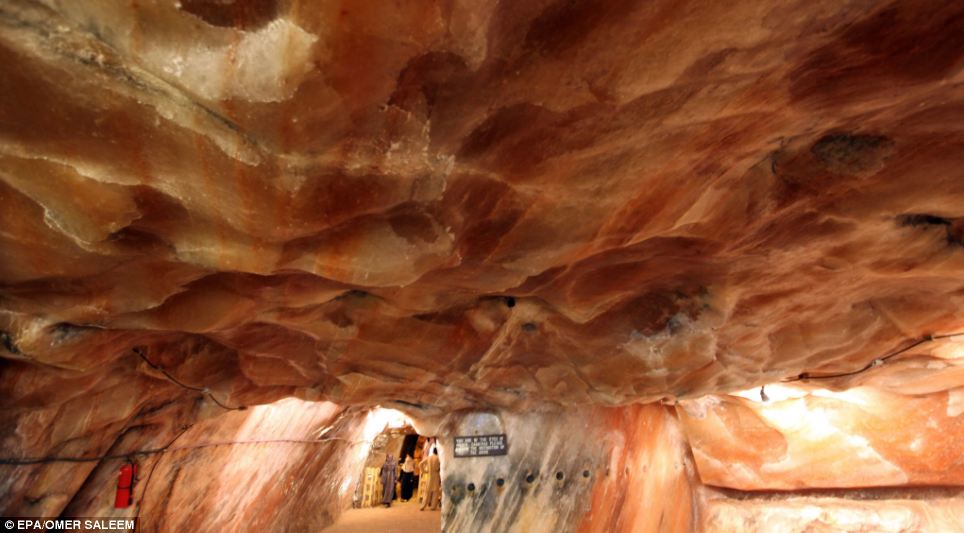

Contents
1 Geology
2 History
3 Mineral composition
4 Uses
5 See also
6 References
7 External links
Geology
Himalayan salt

Salt from Khewra Salt Mine near Khewra,
Himalayan salt is mined from the Salt Range mountains, the southern edge of a fold-and-thrust belt that underlies the Pothohar Plateau south of the Himalayas. Himalayan salt comes from a highly folded, faulted, and stretched thick layer of Ediacaran to early Cambrian evaporites of the Salt Range Formation. This geological formation consists of crystalline halite intercalated with potash salts, overlayed by gypsiferous marl and interlayered with beds of gypsum and dolomite with infrequent seams of oil shale. These strata and the overlying Cambrian to Eocene sedimentary rocks have been thrust southward over younger sedimentary rocks and eroded to create the Salt Range. Although Himalayan salt is sometimes marketed as "Jurassic Sea Salt", this salt precipitated in subsiding rift basins along the edge of Gondwanaland much earlier, between 600 and 540 million years ago. The Jurassic period took place 145 to 199 million years ago.

Himalayan salt crystals
History
The first records of mining are from the Janjua people in the 1200s. Himalayan salt is mostly mined at the Khewra Salt Mine in Khewra, Jhelum District, Punjab, which is situated in the foothills of the Salt Range hill system in the Punjab province of the Pakistan to the Indo-Gangetic Plain.
Mineral composition
Himalayan salt crystals
Himalayan salt is chemically similar to table salt. Some salts mined in the Himalayas are not suitable for use as food or industrial use without purification due to impurities. Some salt crystals from this region have an off-white to transparent color, while impurities in some veins of salt give it a pink, reddish, or beet-red color.
Analysis shows the main content of Himalayan salt to be about 96% sodium chloride, with the remaining content consisting of typical minerals, most in minute quantity.
Himalayan salt is nutritionally similar to common table salt, though it lacks the beneficial iodine added to commercial iodised table salt.
Uses
Salt rock lamp

Himalayan salt is used to flavor food. It is recognized by its distinctive pink hue, which has led to a misconception that it is healthier than common table salt. There is no scientific evidence to support such assertions. Blocks of salt are also used as serving dishes, baking stones, and griddles. In the United States, the Food and Drug Administration warned a manufacturer about marketing the salt as a dietary supplement with unproven claims of health benefits.
Himalayan salt is also used to make "salt lamps", wherein light bulbs are placed within hollowed blocks of Himalayan salt, that give off a pinkish hue. There is no evidence that such lamps provide any health benefits.
Himalayan salt is also used in spas, where it is used to line the walls of the chamber. There is no scientific evidence that such spa treatments have any health benefit.
https://en.wikipedia.org/wiki/Himalayan_salt













